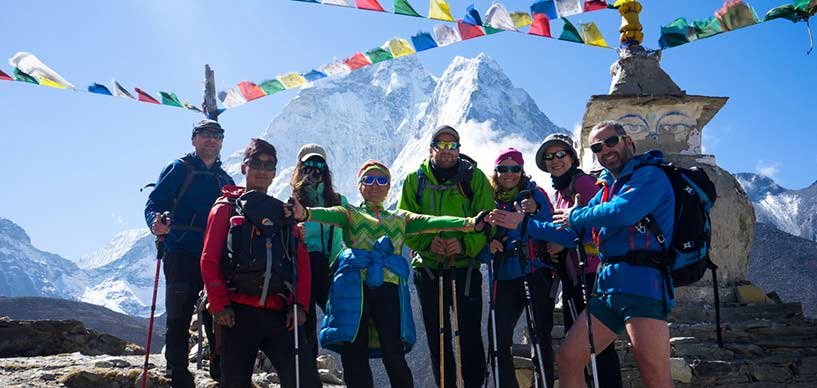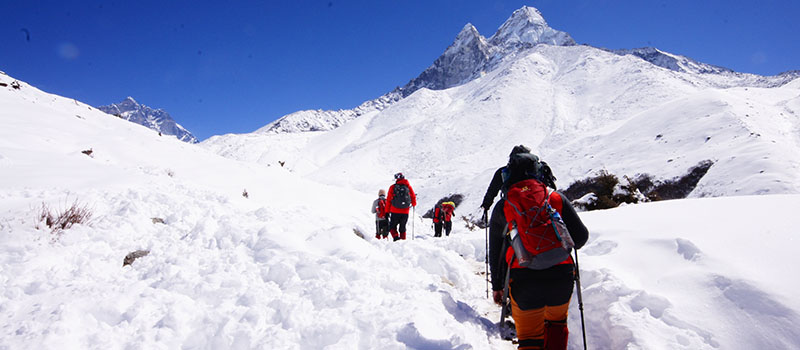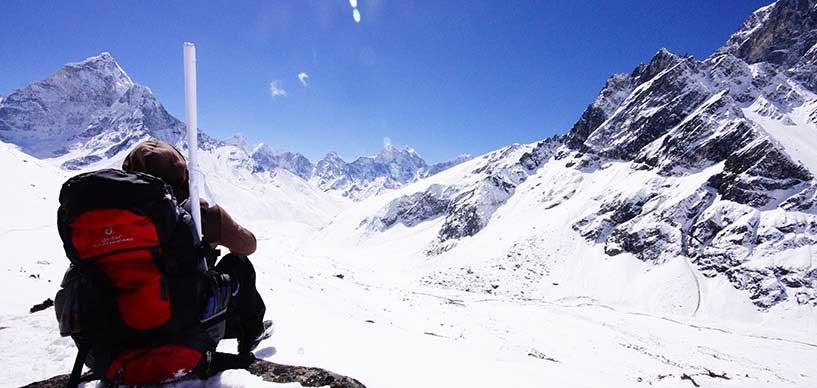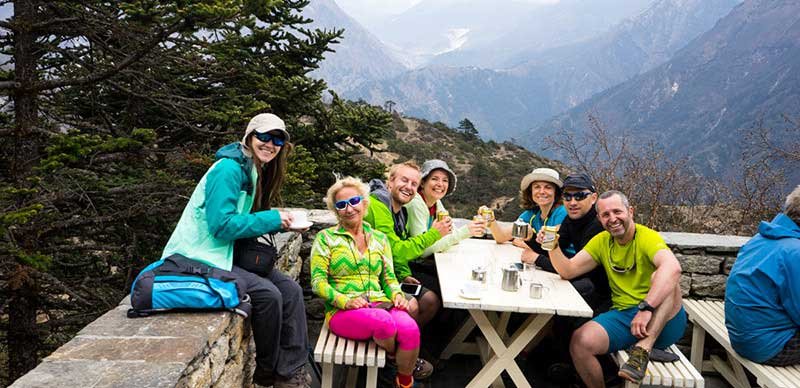Everest Base Camp Trek Diffculty-Tips to reduce challenges

- 08-Jul-2016
- 0
One of the most repetitive questions often gets asked how difficult the Everest Base Camp trek is and how it compares to other popular treks like Annapurna Base Camp, Manaslu Circuit, or Kilimanjaro.
When an adventure-seeking person, like you, lists out the trek to Everest Base Camp in his/her ‘To-Do List’, one of the first questions that pop out is about its difficulty. So how difficult is it? Or what is Everest base camp trek difficulty? Simply stating, hiking all the way up to Everest Base Camp is not like strolling around on a sea beach or walking in a park; this walk in the hilly and higher altitude needs to be respected, prepared, and trained for. Though sometimes this walk can be daunting for novice trekkers, it’s moderately strenuous and still achievable for almost everyone!
Having said that, we now bring to your attention the following crucial areas that shall give you some idea on Everest base camp trek difficulty and make you need to consider and prepare accordingly, for your successful trek in the Everest region.
Several factors are responsible to determine the level of difficulties of any treks. Elevation gained length of the trek, duration of the journeying, altitude sickness, the route is chosen, prior experiences, proper training, and many others.
On the way, we can see thousands of people who make the trek through the Khumbu valley to Everest Base Camp each year and the trek is fully doable for someone having a basic level of aptness.
Nevertheless, there are some deliberations that one needs to take into account before embarking on the EBC trek. With the ventures and pleasing memories come some dares as well during this trek. I have explained those factors which create challenges and ways to overcome them.
Everest Base Camp Trek Difficulty: Altitude

Now when you are trekking to higher altitudes like in the Everest region, altitude is the most crucial factor to consider; the walk-in rough terrain, icy and moraine landscape is made more difficult when you are in higher altitude than in lower elevations.
The pace has to be adjusted according to altitude and fast ascent leads to Altitude Mountain Sickness (AMS), a condition which can lead to difficulty in various ways and, at its worst, to death due to the biological reaction of the human body to a lesser-oxygen environment, which cannot be underestimated.
Acclimatize at Namche Bazaar (3440m) which is suitable for acclimatization in higher altitudes in the region and, before that, in the trek from Lukla as well you should not make a rushed walk. The highest altitude is 5545 meters at Kala Patthar and the Everest Base Camp is 5364m.
Always consider an itinerary with proper scope for acclimatization and in the field follow the advice of a trekking guide. Everyone is at risk due to altitude and you, besides the trekking guides, need to be aware of the symptoms and treatments of altitude sickness.
Everest Base Camp Trek Difficulty: Length of the trail

When you are on this trek, you have come from comfy couches to follow the footsteps of Sir Edmund Hillary and Tenzing Norgay. This trek of around 65 km from Lukla to Everest Base Camp (130 km round-trip), may or may not be a long-distance for you to walk by.
Because the average walking speed of an individual here is found to be about 5 km an hour, even a novice trekker may not consider Everest Base Camp much far from Lukla, and with a light backpack, this walk may be eased a bit. There are some cautions as well. You will be at a higher altitude and that’s the most crucial thing as mentioned earlier.
In a terrain that can often be steep, rocky and slow going, and sometimes icy and snowy, this length may feel like a long one. So you need to prepare yourself accordingly, mentally and physically.
Everest Base Camp Trek Difficulty: Unpredictable Weather
Another major challenge of this trek is unpredictable weather conditions which are hard to predict in the Everest region. We only can assume it according to the previous records and the predisposition of weather change. Weather predictions are estimated on how sustainable weather a particular season witnessed in the previous years.
In a single day, we can experience a drastic variation in the day and night temperature. Nights are cooler than the days. The months of spring (March-May) and autumn (September to November) are most constant in terms of weather change. In the summer/monsoon and winter, the weather remains mostly unstable and can see sharp variations within a single day.
Doing Everest Base Camp Trek in the bad weather is quite daring. Nobody can predict how worse the weather can get, once it begins to be. Due to such conditions, you may have to be stuck in the same teahouses for some days.
Lukla Airstrip is one of the most enthralling airports on the planet. For landing and take-off, it needs to have clear weather and the sky should be open up. During the winter and summer months, the chances of flight cancellation are very high in comparison to the spring and autumn months.
Everest Base Camp Trek Difficulty: Temperature
The average temperature at Everest Base Camp is about 10-15 degrees Celsius on a sunny day during the spring and autumn months. In the summer periods, the temperature ranges from 15-20 degrees Celsius. There might be heavy snowfall in the winter months decreasing the temperature up to negative 20-25 degree Celsius in the nighttime. In the daytime, you can witness dazzling peaks and snowy surroundings.
Whenever you trek, need to be well prepared for the unpredictable weather conditions causing drastic changes in temperatures. Pack well, determine yourself, be affirmative, and obey your leader to complete this trip successfully in any season.
Everest Base Camp Trek Difficulty: Altitude Sickness
One of the major challenges while walking in the Himalayas is elevation sickness. Here, the oxygen and atmospheric pressure are relatively lower than sea level. Due to this, your body might not be adjusted in the surrounding atmosphere and may show the symptoms like nausea, vomiting, headache, dizziness, fatigue, loss of appetite, insomnia, diarrhea, and many others. This condition is defined as Acute Mountain Sickness.
Major Symptoms
- Vomiting and nausea
- Difficult to sleep
- Effects similar to a hangover
- Difficulty in breathing
- Cough
- Foam in saliva( might contain blood)
- Dizziness/giddiness
- Unclear vision/confusion
- Difficulty in walking/fatigue
- Headache
In case such symptoms are seen, should immediately hike down to the lower elevations. It can be moderate for some while for others it can be serious. You should never ignore any such symptoms while trekking high elevations, especially above 3000m.
Your journey to Everest Base Camp begins from Lukla which is 2800m above sea level. You will have to reach Everest Base Camp at 5360m and Kala Patthar at 5545m within 8 days having 2 acclimatization days in Namche and Dingboche. It is crucial to acclimate your body at different stops.
Some preparation before the trip is highly recommended. Some cardiovascular activities, walking with a backpack for few hours each day, practice walking ups and downs helps to succeed in the trek easily. Staying hydrated yourself and having warm liquid foods and sustaining your diet is also a way to lessen the risk of altitude sickness.
Everest Base Camp Trek Difficulty: Accommodation, Food, and Drinks
Everest Base Camp Trek is a famous teahouse trek in Nepal that takes you to the beautiful and traditional mountain lodges/ teahouses of the Khumbu region. The teahouses in the Everest region offer you basic amenities. If you are a luxury seeker, the teahouse trekking can be quite unsatisfactory.
Generally, teahouses offer both lodging and food services. Most of the rooms especially in the higher elevations are on twin sharing basis. A room has two beds. You will be provided a blanket, pillow, and mattress. Also, you have to use the toilets and bathrooms on a shared basis. You can some extra amount, getting a hot shower is possible in at some places.
With the elevation increases, the availability of varieties decreases during the EBC trek. Although most of them have set, do not expect a long food menu. The food and drinks they offer have limited choices. Drinks contain a few hot drinks like tea and coffee.
The cost of bottled water may reach the top with the elevation. It is better to carry a water purification system and a refillable water bottle. Make sure you will drink pure water and good food.
Everest Base Camp Trek Difficulty: Types of Trekkers
Trekkers having previous trekking experiences and skills find this trek doable without much difficulty. It is a quite easier and achievable trek for any trekkers who can walk on rough terrains for 5-6 hours a day in high altitude areas.
For novice travelers, this trek will be a distinct experience and it will take a bit more time to cover the estimated distance. To avoid the hazards, it is highly recommended for you to make up the habit of waking up hills and down hills for a few hours every day. Doing this increases your walking strength.
The novice hikers are highly advised to walk with a guide and a porter as it is quite challenging to walk in a rocky and steep trail with a heavy backpack. By doing so, you will enjoy stress-free moments and a comfortable walk.
Everest Base Camp Trek Difficulty: Training and Preparation

Trek to Everest Base Camp is moderately strenuous and hence you need to have above-average physical fitness. You don’t need to be an athlete or a young individual for successful accomplishment in this trek, though being in great shape is a bonus! Expect some days to be easier and some others to be tough which requires you to get prepared for the worst-case scenario.
It is advised that you prepare a training plan several weeks ahead of the trek and in your training scheme include physical training including aerobic exercises, strength training at the gym, and developmental strength to endure the odds during the trek.
Such training makes your trek more enjoyable and highly increases the chance of a successful trek. In addition to that, during the trek, you need to pack optimally and shouldn’t include unnecessary items or exclude necessary ones.
Everest Base Camp Trek Difficulty: Hiring a Porter/ Guide
Although trekking in Everest Base Camp is possible with or without a trekking guide, hiring them will be a lot easier. You might feel exhausted at the end of the day making it difficult to enjoy the views of dazzling peaks.
The total distance of Everest Base Camp Trek is 130 kilometers where you should pass a plethora of ups and downs. So, hiring a porter makes you much easier as you won’t have to carry your heavy backpack in such up and downhills.
Likewise, hiring a guide helps you to find the route accurately as they are already been there. They help you to find the best teahouse for accommodation and a perfect stop for lunch on the way. They will be helpful in emergence conditions as well.
Tips for Everest Base Camp Trekking
- Trekking in the Himalayas in spring (March to May) and autumn (September to December) is highly advised. These are considered as the high seasons for trekking Everest.
- Be extra careful and prepared if you want to trek in off-season months. You need to tackle the muddy trails, rainy days and floods in the rivers in the monsoon and snowy trails, chill atmosphere in the winter. But the views look magnificent and days are favorable during this period
- While trekking always walks through the edge of the trails. Animals as yaks, donkeys, mules pass by
- Stay hydrated; it is the key measure to escape from Acute Mountain Sickness
- Walk high; sleep low
- Never rush; rushing may cause problems
- Acclimatize properly. Adjusting in the high elevations is crucial
- Expect basic services during the trek; it is inaccessible to get luxurious amenities in the Himalayas
- Begin the trek as early as possible; you can reach the destination on time
- Trek with guides and porters; along with convenience, it helps on sustainable tourism as well.
Final Words

Let us summarize things for you: you don’t need ropes and ice axes and there is no vertical climbing involved but Terrain is rocky, rough, and gravel sprinkled, most of the trek has long paths, and depending on the season you may have to walk on snow and ice in the trails.
In addition to that, you may encounter some boulder that needs climbing, has many sections of steep climb and descends, and in the vicinity of base camp, you have to cautiously walk on surface with potholes and unsettled ground. Respect the trek and get prepared for the worst to get the best!
We hope that this has provided you some idea as to the level of Everest base camp trek difficulty and shall help you with your preparation for the trek. Best wishes for your Everest Trek!




